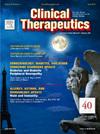阿奇霉素对儿童和青少年囊性纤维化患者肺功能的影响:一项系统综述和荟萃分析
IF 3.6
4区 医学
Q2 PHARMACOLOGY & PHARMACY
引用次数: 0
摘要
目的:本研究旨在通过随机对照试验(RCTs)的系统评价和荟萃分析,评价阿奇霉素对囊性纤维化(CF)患儿肺功能的影响。本研究主要关注其对FEV1(1秒用力呼气量)、FVC(用力肺活量)及肺功能衰退进展的影响。方法:通过PubMed、Cochrane Central、Embase、Web of Science和中国国家知识基础设施数据库进行电子检索,包括截至2024年11月1日发表的研究。纳入标准要求包括CF患儿、阿奇霉素干预和安慰剂对照的随机对照试验。采用随机效应模型进行meta分析,采用I²统计量评估异质性。进行敏感性分析以确保结果的稳健性。结果:纳入8项随机对照试验,共纳入625名受试者。meta分析显示,与对照组相比,阿奇霉素显著改善了FEV1,标准化平均差异(SMD)为0.58 (95% CI: 0.03-1.14),但存在很大的异质性(I²= 82.8%)。然而,FVC无统计学意义的改善(SMD: 0.62, 95% CI: -0.04 ~ 1.29, I²= 85.4%)。此外,阿奇霉素降低了肺功能下降的相对风险(RR: 0.79, 95% CI: 0.62-1.00),具有中等异质性(I²= 45.5%)。敏感性分析证实了这些结果的稳定性。意义:阿奇霉素可能通过其抗炎和免疫调节作用,在改善囊性纤维化儿童FEV1和减缓肺功能下降方面显示出潜力。需要进一步的大规模研究来确认其长期疗效,评估安全性,优化治疗策略,包括潜在的联合治疗。本文章由计算机程序翻译,如有差异,请以英文原文为准。
The Impact of Azithromycin on Lung Function in Children And Adolescents with Cystic Fibrosis: A Systematic Review And Meta-Analysis
Purpose
This study aims to evaluate the effects of azithromycin on lung function in children with cystic fibrosis (CF) through a systematic review and meta-analysis of randomized controlled trials (RCTs). The study primarily focuses on its impact on FEV1 (forced expiratory volume in 1 second), FVC (forced vital capacity), and the progression of lung function decline.
Methods
Electronic searches were conducted across PubMed,Cochrane Central, Embase, Web of Science, and China National Knowledge Infrastructure databases, including studies published up to November 1, 2024. Inclusion criteria required RCTs involving children with CF, azithromycin as the intervention, and placebo controls. Meta-analyses were performed using random-effects models, and heterogeneity was assessed using the I² statistic. Sensitivity analyses were conducted to ensure the robustness of results.
Findings
Eight RCTs were included, covering a total of 625 participants. Meta-analysis revealed that azithromycin significantly improved FEV1 compared to the control group, with a standardized mean difference (SMD) of 0.58 (95% CI: 0.03–1.14), though substantial heterogeneity was observed (I² = 82.8%). However, no statistically significant improvement in FVC was detected (SMD: 0.62, 95% CI: -0.04 to 1.29, I² = 85.4%). Additionally, azithromycin reduced the relative risk of lung function decline (RR: 0.79, 95% CI: 0.62–1.00), with moderate heterogeneity (I² = 45.5%). Sensitivity analyses confirmed the stability of these results.
Implications
Azithromycin shows potential in improving FEV1 and slowing lung function decline in children with cystic fibrosis, likely through its anti-inflammatory and immunomodulatory effects. Further large-scale studies are warranted to confirm its long-term efficacy, evaluate safety, and optimize treatment strategies, including potential combination therapies.
求助全文
通过发布文献求助,成功后即可免费获取论文全文。
去求助
来源期刊

Clinical therapeutics
医学-药学
CiteScore
6.00
自引率
3.10%
发文量
154
审稿时长
9 weeks
期刊介绍:
Clinical Therapeutics provides peer-reviewed, rapid publication of recent developments in drug and other therapies as well as in diagnostics, pharmacoeconomics, health policy, treatment outcomes, and innovations in drug and biologics research. In addition Clinical Therapeutics features updates on specific topics collated by expert Topic Editors. Clinical Therapeutics is read by a large international audience of scientists and clinicians in a variety of research, academic, and clinical practice settings. Articles are indexed by all major biomedical abstracting databases.
 求助内容:
求助内容: 应助结果提醒方式:
应助结果提醒方式:


